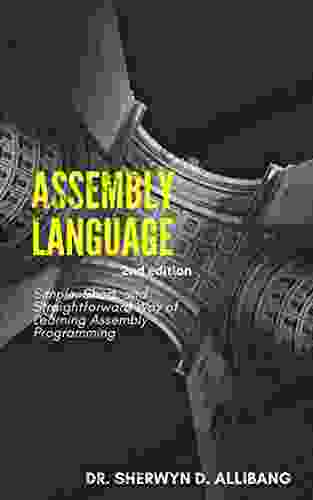A Comprehensive Guide to Demystifying Assembly Programming: Simplifying the Learning Journey

Assembly programming, the direct manipulation of computer hardware through low-level instructions, may seem intimidating at first. However, with a structured approach and unwavering determination, mastering assembly programming can be an enriching and rewarding experience. This article aims to provide a comprehensive guide to simplify the learning process, making assembly programming accessible to aspiring programmers and enthusiasts alike.
Decoding Assembly Language: A Foundation for Understanding
Assembly language, the bridge between human-readable code and machine-executable instructions, consists of mnemonics, symbolic representations of specific operations. These mnemonics, such as "MOV" for moving data or "ADD" for addition, provide a straightforward way to interact with the computer's hardware. Unlike high-level languages that abstract away hardware details, assembly programming offers direct control and fine-grained manipulation, empowering programmers to optimize performance and delve into the intricate workings of computers.
5 out of 5
| Language | : | English |
| File size | : | 53772 KB |
| Text-to-Speech | : | Enabled |
| Screen Reader | : | Supported |
| Enhanced typesetting | : | Enabled |
| Word Wise | : | Enabled |
| Print length | : | 166 pages |
| Lending | : | Enabled |
Essentials of Assembly Programming: A Step-by-Step Approach
Embarking on the assembly programming journey requires a solid foundation in its core concepts. Here's a step-by-step breakdown to get you started:
1. Understanding Registers
Registers, high-speed memory locations within the CPU, play a crucial role in assembly programming. They serve as temporary storage for data and instructions, enabling efficient processing and rapid access to frequently used values.
2. Assembling Instructions
Assembly instructions, composed of opcodes (operation codes) and operands (data or memory addresses),dictate specific actions for the computer to execute. Assemblers, specialized software tools, translate these instructions into machine-understandable binary code, bridging the gap between human-written code and executable programs.
3. Memory Management: The Art of Data Organization
In assembly programming, memory management is paramount. Understanding the memory layout, addressing modes, and data structures empowers programmers to efficiently allocate and manipulate data, ensuring optimal performance and error-free execution.
4. Input and Output Operations: Interacting with the World
Assembly programs often interact with the external world through input and output operations. This involves managing input devices like keyboards and output devices like monitors, enabling programs to receive user input and display information.
5. Control Flow: Guiding Execution and Decision-Making
Control flow instructions, such as branching and looping, provide the means to alter the sequential execution of assembly programs. These instructions allow for conditional execution, loop iterations, and subroutine calls, adding versatility and control to program logic.
Tools of the Trade: Embracing Essential Software
Assembly programming requires specialized software tools to facilitate development. Here are some essential tools to consider:
1. Assemblers: Translating Code into Executable Instructions
Assemblers are the gatekeepers of assembly programming, translating human-readable assembly code into machine-executable binary code. They play a vital role in converting the symbolic instructions into a format that the computer can directly execute.
2. Debuggers: Unraveling Errors and Optimizing Code
Debuggers are essential troubleshooting tools that allow programmers to step through assembly code line by line, examining register contents, memory values, and execution flow. This helps pinpoint errors, identify inefficiencies, and optimize code for better performance.
3. Emulators: Simulating Environments for Testing and Debugging
Emulators provide a simulated environment to execute and test assembly programs without the need for specialized hardware. They offer a convenient and cost-effective way to develop and debug code, especially when targeting different architectures or embedded systems.
Practical Applications: Assembly Programming in the Real World
Assembly programming finds applications in various domains, including:
1. Operating Systems: The Core of Computer Systems
Assembly programming plays a crucial role in developing operating systems, the backbone of computers. It enables direct hardware manipulation, optimizing performance and providing low-level control over system resources.
2. Embedded Systems: Powering Specialized Devices
In embedded systems, where size, power consumption, and real-time performance are critical, assembly programming offers the necessary precision and control to optimize code for specific hardware platforms.
3. Device Drivers: Interfacing with Hardware
Assembly programming is often employed in writing device drivers, the software that enables communication between operating systems and hardware devices. It provides the fine-grained control needed to interact with hardware registers and memory.
: Embracing the Journey of Assembly Programming
Assembly programming, despite its reputation as a challenging endeavor, can be a rewarding and transformative experience. By understanding its core concepts, leveraging essential tools, and delving into practical applications, aspiring programmers can unlock the power of direct hardware manipulation and gain a deeper appreciation for the inner workings of computers. Remember, the journey of assembly programming is not just about mastering a language but about gaining a profound understanding of the underlying architecture and embracing the intricacies of computer science. With persistence and a thirst for knowledge, anyone can conquer the complexities of assembly programming and harness its potential to create efficient, optimized, and hardware-centric software solutions.
5 out of 5
| Language | : | English |
| File size | : | 53772 KB |
| Text-to-Speech | : | Enabled |
| Screen Reader | : | Supported |
| Enhanced typesetting | : | Enabled |
| Word Wise | : | Enabled |
| Print length | : | 166 pages |
| Lending | : | Enabled |
Do you want to contribute by writing guest posts on this blog?
Please contact us and send us a resume of previous articles that you have written.
 Book
Book Novel
Novel Page
Page Library
Library E-book
E-book Magazine
Magazine Newspaper
Newspaper Glossary
Glossary Preface
Preface Annotation
Annotation Codex
Codex Tome
Tome Bestseller
Bestseller Classics
Classics Library card
Library card Narrative
Narrative Biography
Biography Memoir
Memoir Encyclopedia
Encyclopedia Dictionary
Dictionary Thesaurus
Thesaurus Character
Character Resolution
Resolution Librarian
Librarian Catalog
Catalog Archives
Archives Periodicals
Periodicals Research
Research Scholarly
Scholarly Lending
Lending Reserve
Reserve Journals
Journals Reading Room
Reading Room Interlibrary
Interlibrary Study Group
Study Group Thesis
Thesis Dissertation
Dissertation Storytelling
Storytelling Book Club
Book Club Textbooks
Textbooks Joi Marie Mckenzie
Joi Marie Mckenzie Margie Miklas
Margie Miklas Richie Furay
Richie Furay Charles M Robinson
Charles M Robinson Nc Marshall
Nc Marshall James F Gauss
James F Gauss Erik Varden
Erik Varden Jonathan Swift
Jonathan Swift Catherine Tidd
Catherine Tidd Jenifer Ruff
Jenifer Ruff C K Crigger
C K Crigger Warwick Anderson
Warwick Anderson Sonya Kelly
Sonya Kelly Matthew Stock
Matthew Stock Dennis C Brewer
Dennis C Brewer Homer Hickam
Homer Hickam Scott Tennant
Scott Tennant Hannah Hurnard
Hannah Hurnard Mark Polanzak
Mark Polanzak Earl Rogers
Earl Rogers
Light bulbAdvertise smarter! Our strategic ad space ensures maximum exposure. Reserve your spot today!

 Oliver FosterThe Shocking True Story of Toxic Thoughts: How Your Second Secret Life Can...
Oliver FosterThe Shocking True Story of Toxic Thoughts: How Your Second Secret Life Can...
 Kenneth ParkerPhilosophy in Geography: Exploring the Nexus of Space, Society, and Thought
Kenneth ParkerPhilosophy in Geography: Exploring the Nexus of Space, Society, and Thought
 Blake KennedyThe Pursuit of Freedom and Equality in the Twilight of Slavery: Littlefield's...
Blake KennedyThe Pursuit of Freedom and Equality in the Twilight of Slavery: Littlefield's... Harry HayesFollow ·8.6k
Harry HayesFollow ·8.6k Reed MitchellFollow ·17.2k
Reed MitchellFollow ·17.2k Marcus BellFollow ·18.5k
Marcus BellFollow ·18.5k Henry Wadsworth LongfellowFollow ·10.3k
Henry Wadsworth LongfellowFollow ·10.3k Randy HayesFollow ·18.4k
Randy HayesFollow ·18.4k Colton CarterFollow ·11.7k
Colton CarterFollow ·11.7k Giovanni MitchellFollow ·11.8k
Giovanni MitchellFollow ·11.8k Ryan FosterFollow ·7.3k
Ryan FosterFollow ·7.3k

 Gary Reed
Gary ReedWeb to Web for Beginners: A Comprehensive Guide to...
In today's interconnected world, websites...

 Elliott Carter
Elliott CarterThe Moon Is Down: John Steinbeck's Poignant Portrait of...
In the annals of literature, John...

 Dalton Foster
Dalton FosterMark The Mechanic: The Incredible Story Of A Young...
In the vibrant realm of robotics, where...

 Fred Foster
Fred FosteriPhone 13 Pro Max User Guide: Everything You Need to Know
The iPhone 13 Pro Max...

 Rodney Parker
Rodney ParkerPope John Paul II: The Pocket Giant Who Inspired Millions
Pope John Paul II, or...
5 out of 5
| Language | : | English |
| File size | : | 53772 KB |
| Text-to-Speech | : | Enabled |
| Screen Reader | : | Supported |
| Enhanced typesetting | : | Enabled |
| Word Wise | : | Enabled |
| Print length | : | 166 pages |
| Lending | : | Enabled |








